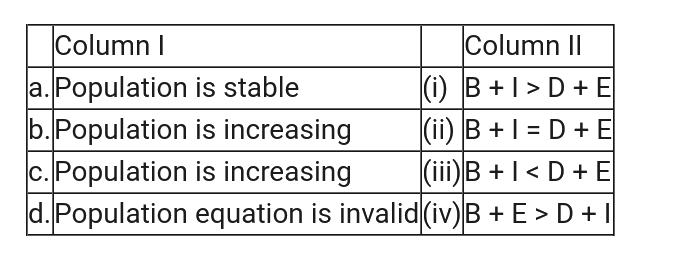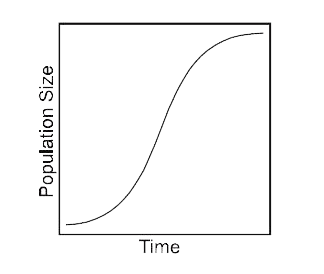If a\ new habitat is just being colonised, ..1..may contribute more significantly to population growth than ..2..(where b = birth rate, E = Emigration, I = Irrigation).
1−b, 2−E
1−I, 2−b
1−I, 2−E
1−b, 2−I
The correct Answer is:B
To solve the question, we need to fill in the blanks with appropriate terms related to population dynamics in a newly colonized habitat.
1. Understanding the context: The question discusses a new habitat that is just being colonized. In such a scenario, we need to consider how population growth occurs.
2. Identifying factors affecting population growth: The two main factors that contribute to population growth are:
- Birth rate (b): This refers to the number of births in a population over a specific period.
- Immigration (I): This refers to the movement of individuals into a population from other areas.
3. Analyzing the situation: In a newly colonized habitat, the population may not have established itself enough for reproduction to occur immediately. Therefore, the birth rate may be low initially.
4. Determining which factor is more significant: Since the habitat is new and may not have many individuals reproducing yet, immigration (the arrival of individuals from other populations) may play a more significant role in increasing the population size than the birth rate.
5. Filling in the blanks: Based on the analysis:
- For blank 1, we can fill in "Immigration" (I) because it may contribute more significantly to population growth.
- For blank 2, we can fill in "Birth rate" (b) since it is likely to be lower in a newly colonized habitat.
Thus, the completed statement is:
"If a new habitat is just being colonized, immigration may contribute more significantly to population growth than birth rate."
- Birth rate (b): This refers to the number of births in a population over a specific period.
- Immigration (I): This refers to the movement of individuals into a population from other areas.
- For blank 1, we can fill in "Immigration" (I) because it may contribute more significantly to population growth.
- For blank 2, we can fill in "Birth rate" (b) since it is likely to be lower in a newly colonized habitat.
"If a new habitat is just being colonized, immigration may contribute more significantly to population growth than birth rate."
Topper's Solved these Questions
- ORGANISMS AND POPULATIONS BOOK - A2ZCHAPTER - ORGANISMS AND POPULATIONS EXERCISE - Section A: Topicwise Questions (topic 5: Population Interactions)
60 Videos
- ORGANISMS AND POPULATIONS BOOK - A2ZCHAPTER - ORGANISMS AND POPULATIONS EXERCISE - Section B: Assertion-reasoning Questions
26 Videos
- ORGANISMS AND POPULATIONS BOOK - A2ZCHAPTER - ORGANISMS AND POPULATIONS EXERCISE - Section A: Topicwise Questions (topic 3: Adaptions)
21 Videos
- MOLECULAR BASIS OF INHERITANCEBOOK - A2ZCHAPTER - MOLECULAR BASIS OF INHERITANCEEXERCISE - Section D: Chapter -end Test
50 Videos
- PRINCIPLES OF INHERITANCE AND VARIATIONBOOK - A2ZCHAPTER - PRINCIPLES OF INHERITANCE AND VARIATIONEXERCISE - SECTION A : TOPICWISE QUESTIONS ((TOPIC 1: MENDEL'S LAW OF INHERITANCE)
22 Videos
Similar Questions
(a) Write an equation for Verhulst Pearl logistic . Growth where
N = Population density at a time t
r = Intrinsic rate of natural increase
K = Carrying capacity
(b) Draw a graph for a population whose population density has reached the carrying capacity .
(c) Why is the logistic growth model considered a more reallistic one for most animal populations ?
(d) Draw a growth curve where resources are not limiting to growth of a population.
View SolutionIf birth rate = B , Death rate = D, Emigration = E, lmmigration = I, then choose the correct match

View Solution
Knowledge Check
If (B + 1) is more than (D + E) than population will
AincreaseBdecreaseCremain sameDNone of theseIf 'K' is the carrying capacity of the habitat, 'N' is the total number of individuals in a population with intrinsic rate of reproduction as 'r' the growth rate of such a population will be directly proportional to :
I. r.
II. 1/N
III. 1/K-N
IV. (K-N)/KAI and IIBII and IIICI and IVDOnly IMany population colonising a new habitat show a logistic population growth pattern over time, as shown in the figure below.

In such a population, the POPULATION growth rateAstays constant over timeBincreases and then reaches an asymptoteCdecreases over timeDincreases to a maximum and then decrease
Map Skill On an outline map of the world name the following:
(a) Countries of Europe and Asia with negative growth rate of population.
(b) African countries with growth rate of population more than three per cent.
View SolutionConsider the following statement.
1. The rate of population growth is increasing in the country.
2. The death rate is declining faster in the country compared to birth rate.
3. The birth rate is declining faster in the country compared to death rate.
4. Rural-urban migration is taking place regularly in the country.
Which one of the following conclusions may be true in the light of the above facts?
View SolutionThe rate law expresison is given for a typical reaction, n1A+n2B→P as r=k[A]n[B]n2. The reaction completes only in one step and A and B are present in the solution. If the reaction occurs in more than one step, then the rate law is expressed by consdering the slowest step, i.e., for SNl reaction r=k[RX]. If the eraction occurs in more than one step and the rates of the steps involved are comparable, then steady state approximation is conisdered, i.e., the rate of formation of intermediate is always equal to the rate of decompoistion of the intermediate. Conisder the reaction:
⎡⎢ ⎢⎣I2k2⇐⇒k12I(rapid equilibrium)H2+2Ik3−−→2HI(slow)⎤⎥ ⎥⎦
If we increase the concentration of I2 two times, then the rate of formation of HI will
View SolutionThe rate law expresison is given for a typical reaction, n1A+n2B→P as r=k[A]n[B]n2. The reaction completes only in one step and A and B are present in the solution. If the reaction occurs in more than one step, then the rate law is expressed by consdering the slowest step, i.e., for SNl reaction r=k[RX]. If the eraction occurs in more than one step and the rates of the steps involved are comparable, then steady state approximation is conisdered, i.e., the rate of formation of intermediate is always equal to the rate of decompoistion of the intermediate. Conisder the reaction:
⎡⎢ ⎢⎣I2k2⇐⇒k12I(rapid equilibrium)H2+2Ik3−−→2HI(slow)⎤⎥ ⎥⎦
Which of the following expresison is correct?
View SolutionThe American cotton textile industry moved from new England to the Southern States because: (1) The latter have a more humid climate (2) New England diversified its manufacturing industries (3) The population growth in the south provided a major market (4) The south offered lower coast of production
View Solution
